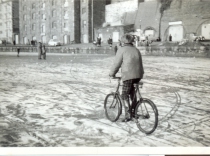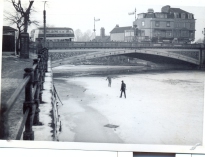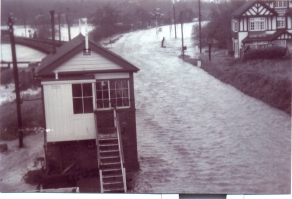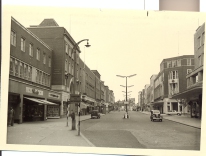
PRE WW2 PHOTOGRAPHS
Talk by David Cornforth 13 August 2015
David Cornforth opened his talk by introducing Michael Wride and Bertram Arden, both having taken many black and white photographs (on the ground and from the air) of Exeter half a century or so ago.
The old bridge (on which trams ran between Fore Street and St Thomas) was shown and we noted its similarity to London’s Tower Bridge - they both had the same designer! A number of views of old streets like James Street (off South Street), Cheeke Street and Bonhay Road appeared, with a view of the old end-of-terrace wall on which the famous mural was painted but alas recently removed.
The old bridge (on which trams ran between Fore Street and St Thomas) was shown and we noted its similarity to London’s Tower Bridge - they both had the same designer! A number of views of old streets like James Street (off South Street), Cheeke Street and Bonhay Road appeared, with a view of the old end-of-terrace wall on which the famous mural was painted but alas recently removed.
Moving to Sidwell Street after the bombing, David pointed out the bombed and badly damaged buildings on the south side but also, not so well known, the bomb shelter on the north side which sadly suffered a direct hit and many were killed.
A number of bombed and burnt buildings were shown. Chaucer’s underground cellar being one that had been cleared – showing that the present underground cellar is not as old as they would like us to believe; it is a rebuild! David pointed out, with photographs, how the Council had widened a number of roads, like North Street, by demolishing the damaged front sections of buildings and rebuilding the fronts further back. Similarly, South Street was widened after the war and original photographs showed it as being much narrower before the war.
A grisly photograph showed a man with a dog and two human bones (which the dog had unearthed) in his arms. It had not previously been known where the bodies of hanged criminals were buried, but as a result of the dog’s activity subsequent excavation a considerable number of skulls and arm/leg bones were unearthed – as shown on more photos. These, we were told, were later relocated to a burial site in Topsham.
Before moving to aerial photography we were shown pictures of the plane used for these. One showed the body of that plane, with wings removed, being pushed along the road, having landed in a cornfield at harvest time and having being unable to take off again from the long corn! A photo of the petrol station and its AA lookout tower was followed by an aerial photo of 1926 showing the Gallows Cross where public hangings had taken place.
We then saw many photographs taken from the air, showing all areas of Exeter as it was fifty or so years ago - the railway, canal and river, the site of what became Middlemoor, the Deaf School, Colleton Crescent, the Gas Works, the Cattle Market, the greyhound track and Speedway, and even a bomb crater left unfilled from the war. Garton & King’s works were shown, much to the delight of our Chairman, Richard.
In closing, one of the photographers’ family descendants who were in the audience thanked David for a fascinating “walk down memory lane”.
|
All these pictures, and many more, are now stored and can be seen on David’s Exeter Memories website - www.exetermemories.co.uk. This is a project he started some 15 years ago and to which he is still adding further material to this day. |




